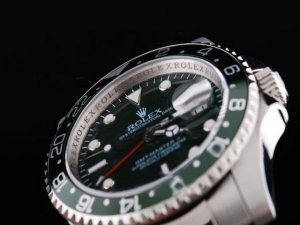

Of all the design details of Rolex GMT-Master, the watch bezel is the most distinctive. GMT-Master features 24-hour markings and the ability to rotate in both directions. Its borders are an important part of the watch’s display of multiple time zones. However, in addition to its functionality, the bezel design also contributes a huge amount to the style of the Rolex GMT Maestro – especially when it’s in a two-tone color scheme.
While the fundamental look of the GMT-Master bezel has remained relatively unchanged over the last six decades, there have been crucial changes to the materials used. Rolex has made an assortment of different bezels for the GMT-Master over the decades. Different materials have been used – Bakelite, aluminum, Cerachrom, and precious gems – and these GMT bezels have been provided in a range of different colors.
When Rolex introduced the first GMT-Master in the mid-1950s, the watch came equipped with a bidirectional rotating bezel with a two-tone Bakelite insert featuring radium luminous markings. Bakelite was the world’s first completely synthetic plastic that was lightweight, pretty durable, and easy to mold into many different shapes at https://www.localdlish.com.
Given those amazing traits, Bakelite was initially considered a good material choice for the bezel insert of the GMT-Master watch. However, it was soon apparent that Bakelite was too brittle and had a tendency to crack – plus the radioactive glowing numerals embedded into it also posed a potential health hazard.
Therefore, the Rolex replica switched over to non-luminous aluminum bezel inserts for later GMT-Master 6542 models in the late 1950s. What’s more, Rolex service centers also typically replaced any damaged Bakelite bezels with aluminum ones. As a result, it’s hard to find an old Rolex GMT-Master 6542 with its original Bakelite bezel, today, and many surviving original Bakelite inserts show obvious signs of wear or damage.
 Rolex made two different Bakelite bezels for the GMT-Master ref. 6542. There was the bi-color blue and red version for the stainless steel models, later nicknamed the “Pepsi” bezel. Legend has it that replica Rolex chose color separation to make it easier for pilots to distinguish between day and night — the red part is day and the blue part is night. Others, however, insist that its two-color appearance was designed to reflect the attitude indicators that were installed on various aircraft at the time. Either way, the separated-color bezels are now considered one of the defining features of Rolex’s GMT-Master line.
Rolex made two different Bakelite bezels for the GMT-Master ref. 6542. There was the bi-color blue and red version for the stainless steel models, later nicknamed the “Pepsi” bezel. Legend has it that replica Rolex chose color separation to make it easier for pilots to distinguish between day and night — the red part is day and the blue part is night. Others, however, insist that its two-color appearance was designed to reflect the attitude indicators that were installed on various aircraft at the time. Either way, the separated-color bezels are now considered one of the defining features of Rolex’s GMT-Master line.


